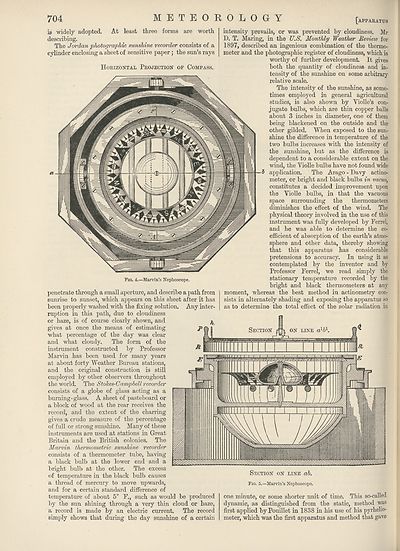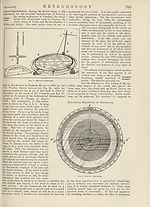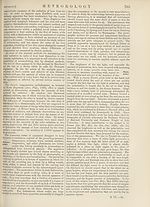New volumes of the Encyclopædia Britannica > Volume 30, K-MOR
(748) Page 704
Download files
Complete book:
Individual page:
Thumbnail gallery: Grid view | List view

704
is widely adopted. At least three forms are worth
describing.
The Jordan photographic sunshine recorder consists of a
cylinder enclosing a sheet of sensitive paper; the sun’s rays
penetrate through a small aperture, and describe a path from
sunrise to sunset, which appears on this sheet after it has
been properly washed with the fixing solution. Any inter¬
ruption in this path, due to cloudiness
or haze, is of course clearly shown, and
gives at once the means of estimating
what percentage of the day was clear
and what cloudy. The form of the
instrument constructed by Professor
Marvin has been used for many years
at about forty Weather Bureau stations,
and the original construction is still
employed by other observers throughout
the world. The Stokes-Campbell recorder
consists of a globe of glass acting as a
burning-glass. A sheet of pasteboard or
a block of wood at the rear receives the
record, and the extent of the charring
gives a crude measure of the percentage
of full or strong sunshine. Many of these
instruments are used at stations in Great
Britain and the British colonies. The
Marvin thermometric sunshine recorder
consists of a thermometer tube, having
a black bulb at the lower end and a
bright bulb at the other. The excess
of temperature in the black bulb causes
a thread of mercury to move upwards,
and for a certain standard difference of
temperature of about 5° F., such as would be produced
by the sun shining through a very thin cloud or haze,
a record is made by an electric current. The record
simply shows that during the day sunshine of a certain
[apparatus
intensity prevails, or was prevented by cloudiness. Mr
D. T. Maring, in the U.S. Monthly Weather Review for
1897, described an ingenious combination of the thermo¬
meter and the photographic register of cloudiness, which is
worthy of further development. It gives
both the quantity of cloudiness and in¬
tensity of the sunshine on some arbitrary
relative scale.
The intensity of the sunshine, as some¬
times employed in general agricultural
studies, is also shown by Violle’s con¬
jugate bulbs, which are thin copper balls
about 3 inches in diameter, one of them
being blackened on the outside and the
other gilded. When exposed to the sun¬
shine the difference in temperature of the
two bulbs increases with the intensity of
the sunshine, but as the difference is
dependent to a considerable extent on the
wind, the Violle bulbs have not found wide
application. The Arago - Davy actino-
meter, or bright and black bulbs in vacuo,
constitutes a decided improvement upon
the Violle bulbs, in that the vacuous
space surrounding the thermometers
diminishes the effect of the wind. The
physical theory involved in the use of this
instrument was fully developed by Ferrel,
and he was able to determine the co¬
efficient of absorption of the earth’s atmo¬
sphere and other data, thereby showing
that this apparatus has considerable
pretensions to accuracy. In using it as
contemplated by the inventor and by
Professor Ferrel, we read simply the
stationary temperature recorded by the
bright and black thermometers at any
moment, whereas the best method in actinometry con¬
sists in alternately shading and exposing the apparatus so
as to determine the total effect of the solar radiation in
Pig. 5.—Marvin’s Nephoscope.
one minute, or some shorter unit of time. This so-called
dynamic, as distinguished from the static, method was
first applied by Pouillet in 1838 in his use of his pyrhelio-
meter, which was the first apparatus and method that gave
METEOROLOGY
Horizontal Projection of Compass.
Fig. 4.—Marvin’s Nephoscope.
Section on line ab.
is widely adopted. At least three forms are worth
describing.
The Jordan photographic sunshine recorder consists of a
cylinder enclosing a sheet of sensitive paper; the sun’s rays
penetrate through a small aperture, and describe a path from
sunrise to sunset, which appears on this sheet after it has
been properly washed with the fixing solution. Any inter¬
ruption in this path, due to cloudiness
or haze, is of course clearly shown, and
gives at once the means of estimating
what percentage of the day was clear
and what cloudy. The form of the
instrument constructed by Professor
Marvin has been used for many years
at about forty Weather Bureau stations,
and the original construction is still
employed by other observers throughout
the world. The Stokes-Campbell recorder
consists of a globe of glass acting as a
burning-glass. A sheet of pasteboard or
a block of wood at the rear receives the
record, and the extent of the charring
gives a crude measure of the percentage
of full or strong sunshine. Many of these
instruments are used at stations in Great
Britain and the British colonies. The
Marvin thermometric sunshine recorder
consists of a thermometer tube, having
a black bulb at the lower end and a
bright bulb at the other. The excess
of temperature in the black bulb causes
a thread of mercury to move upwards,
and for a certain standard difference of
temperature of about 5° F., such as would be produced
by the sun shining through a very thin cloud or haze,
a record is made by an electric current. The record
simply shows that during the day sunshine of a certain
[apparatus
intensity prevails, or was prevented by cloudiness. Mr
D. T. Maring, in the U.S. Monthly Weather Review for
1897, described an ingenious combination of the thermo¬
meter and the photographic register of cloudiness, which is
worthy of further development. It gives
both the quantity of cloudiness and in¬
tensity of the sunshine on some arbitrary
relative scale.
The intensity of the sunshine, as some¬
times employed in general agricultural
studies, is also shown by Violle’s con¬
jugate bulbs, which are thin copper balls
about 3 inches in diameter, one of them
being blackened on the outside and the
other gilded. When exposed to the sun¬
shine the difference in temperature of the
two bulbs increases with the intensity of
the sunshine, but as the difference is
dependent to a considerable extent on the
wind, the Violle bulbs have not found wide
application. The Arago - Davy actino-
meter, or bright and black bulbs in vacuo,
constitutes a decided improvement upon
the Violle bulbs, in that the vacuous
space surrounding the thermometers
diminishes the effect of the wind. The
physical theory involved in the use of this
instrument was fully developed by Ferrel,
and he was able to determine the co¬
efficient of absorption of the earth’s atmo¬
sphere and other data, thereby showing
that this apparatus has considerable
pretensions to accuracy. In using it as
contemplated by the inventor and by
Professor Ferrel, we read simply the
stationary temperature recorded by the
bright and black thermometers at any
moment, whereas the best method in actinometry con¬
sists in alternately shading and exposing the apparatus so
as to determine the total effect of the solar radiation in
Pig. 5.—Marvin’s Nephoscope.
one minute, or some shorter unit of time. This so-called
dynamic, as distinguished from the static, method was
first applied by Pouillet in 1838 in his use of his pyrhelio-
meter, which was the first apparatus and method that gave
METEOROLOGY
Horizontal Projection of Compass.
Fig. 4.—Marvin’s Nephoscope.
Section on line ab.
Set display mode to:
![]() Universal Viewer |
Universal Viewer | ![]() Mirador |
Large image | Transcription
Mirador |
Large image | Transcription
Images and transcriptions on this page, including medium image downloads, may be used under the Creative Commons Attribution 4.0 International Licence unless otherwise stated. ![]()
| Encyclopaedia Britannica > New volumes of the Encyclopædia Britannica > Volume 30, K-MOR > (748) Page 704 |
|---|
| Permanent URL | https://digital.nls.uk/193577225 |
|---|
| Attribution and copyright: |
|
|---|---|
| Shelfmark | EB.18 |
|---|---|
| Description | Ten editions of 'Encyclopaedia Britannica', issued from 1768-1903, in 231 volumes. Originally issued in 100 weekly parts (3 volumes) between 1768 and 1771 by publishers: Colin Macfarquhar and Andrew Bell (Edinburgh); editor: William Smellie: engraver: Andrew Bell. Expanded editions in the 19th century featured more volumes and contributions from leading experts in their fields. Managed and published in Edinburgh up to the 9th edition (25 volumes, from 1875-1889); the 10th edition (1902-1903) re-issued the 9th edition, with 11 supplementary volumes. |
|---|---|
| Additional NLS resources: |
|

